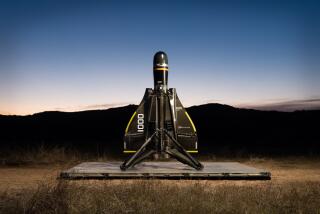Smart Bombs, Cars Target of New Guidance Project : Technology: Rockwell teams up with a Northern California firm to revolutionize the gyroscope, the heart of missile guidance systems. Expanded technology would also apply to domestic uses.
ANAHEIM — Rockwell International Corp. will invest $11 million in a Northern California company to jointly develop a new generation of inexpensive gyroscopes used in navigation, the company said Wednesday.
Robert DeJong, a Rockwell program development manager, said the project is expected to take about two years and that the technology has potential uses in a variety of markets.
“I see this as very significant, not only to Anaheim but to the rest of the corporation,” DeJong said. “We anticipate we will be able to generate jobs in the future but won’t hire anyone right now.”
Rockwell’s Autonetics Strategic Systems Division in Anaheim, which makes guidance systems for the MX missile, will jointly develop the technology with BEI Electronics Inc., a San Francisco technology company. Rockwell will invest $7.8 million in BEI for development and another $3.2 million for engineering and technical support.
Rockwell, based in Seal Beach, is a $12-billion company with far-flung divisions that manufacture both commercial and defense products. In Anaheim, the company recently laid off about 200 workers because of cuts in defense spending.
BEI’s Systron Donner Inertial Division in Concord has developed a patented technology that uses digital quartz technology similar to that used in watches and an electronic chip to replace a traditional gyroscope.
“A gyroscope like this could be orders of magnitude less expensive to produce,” said Brad Sage, director of business development for Systron Donner.
A gyroscope assembly for a missile is typically the most complicated and expensive part of a guided weapon, DeJong said. Such assemblies often contain 100 rotating parts and must be handmade.
BEI’s assembly would have just one rotating part and could be mass produced, Sage said. In addition, it could be used in a wider variety of products, from so-called smart bombs to marine navigation systems and automobiles.
More to Read
Inside the business of entertainment
The Wide Shot brings you news, analysis and insights on everything from streaming wars to production — and what it all means for the future.
You may occasionally receive promotional content from the Los Angeles Times.









